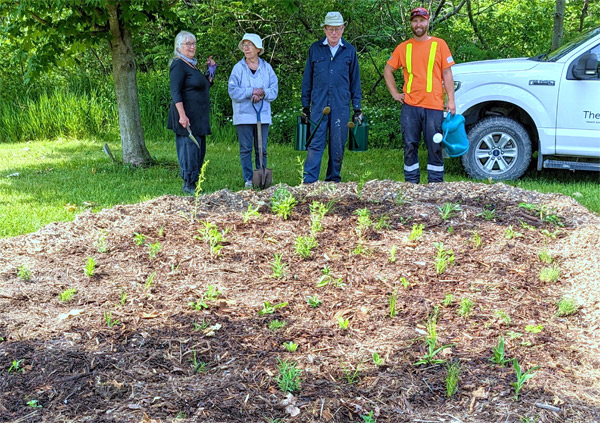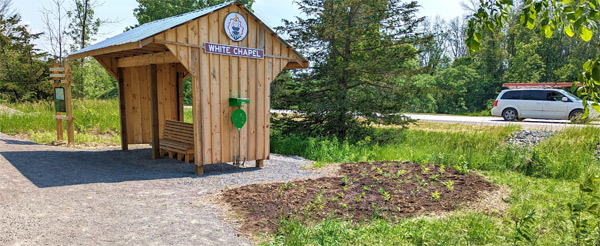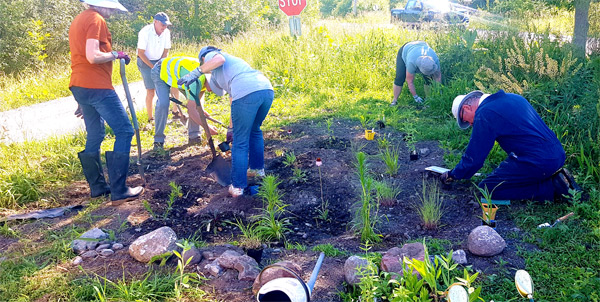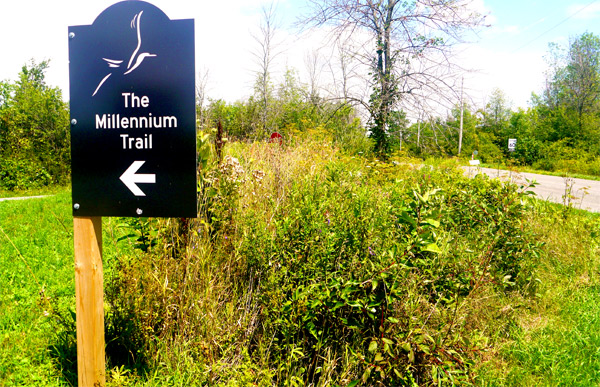Help plant a pollinator garden Monday (no experience necessary)
Administrator | Aug 17, 2023 | Comments 0
By Sharon Harrison
As the benefits of growing pollinator-friendly gardens becomes more widely known and encouraged in Prince Edward County, some residents are transforming their entire garden spaces – or even just a small areas – to growing native perennials.
The idea of growing plants to invite pollinators is being encouraged as many species of butterflies, bees, birds and many insect populations lose vital habitat to feed on, but also a place to lay eggs and live.
As more residents take up the challenge of converting some or all of their yards to planting native species, and specifically pollinator-friendly plants, as well as becoming more informed and educated on the topic, the municipality is also doing its part.
 On Monday, Aug. 21, County Garden Club members (the Prince Edward County Horticultural Society) and local volunteers, in conjunction with the municipality, will be planting a pollinator-friendly garden on municipal land for the benefit of the many species, community, and visitors to the area.
On Monday, Aug. 21, County Garden Club members (the Prince Edward County Horticultural Society) and local volunteers, in conjunction with the municipality, will be planting a pollinator-friendly garden on municipal land for the benefit of the many species, community, and visitors to the area.
The garden site forms two separate areas located at the end of Bakker Road in the County’s west end, near Pleasant Bay beach, a beautiful location with a beach at the end of the path.
While two days have been allocated to plant the garden, Lise Bois, co-chair with the County Garden Club is hoping it can be achieved in one – on the Monday. With about a dozen volunteers signed-up, including garden club members, she is looking ideally for another 16-20 helpers to help share the task.
Gardening volunteers don’t have to have any gardening experience (although it’s a bonus if they do) as garden club members will show folks what to do. And people can show up for an hour, a few hours, or all day, as any contribution will be helpful and appreciated.
“We just need people who are able to dig a hole!” quipped Bois, indicating that gardening experience of any kind isn’t required.
Bois has designed the gardens, selected and purchased the plants, where she and others will arrange the plants in their pots where they should to be planted so volunteer helpers can simply dig a hole and plant where positioned.
“’Designed’ is a loose word; because we are using native plants and we want it to be as natural as possible, so it’s not overly designed,” she said. “We are not so much creating a garden as creating an environment.”
Several members of the municipality’s operations department will also be on-site, led by Albert Paschkowiak, supervisor of environmental services and sustainability at the County.
With the site already prepared by the municipality ahead of planting day, with soil and mulch on hand too, Bois says it should be a relatively easy planting, but notes it is a big site ( 8×16 metres and 7×14 metres), and the largest the club has undertaken in its community planting projects.
“Where it is located, there is a path that leads to the beach and we will be putting in some plants along the path as well.”
While the group will have extra tools for people to use, such as shovels, trowels, etc., if volunteers have them, as well as gardening gloves, they are encouraged to bring them.
She recommends wearing appropriate footwear, not open-toes sandals or the like.
A free lunch and refreshments will be provided to those who contribute volunteer time.
“It’s a fairly large site and we are looking at planting over 1,200 plants, to include some large shrubs in with the plants as well.”
The project has been made possible by a recent grant received from the Canadian Wildlife Federation which the municipality was successful in receiving to develop a pollinator garden.
“This work will have a positive impact on the local and migrating populations of pollinators and other flora and fauna found in the area,” noted the County in a recent release.
“Anyone who is passionate about environmental stewardship and sustainability is welcome to join staff, local residents and members of the County Garden Club.”
These types of planting programs aren’t new to the County Garden Club, as the Bakker Road site will be the seventh such undertaking for the small but dedicated group of volunteers.
The other pollinator-friendly and naturalized areas developed and planted by the club and local volunteers on municipal property include Station Road, Salem Road, Delhi Park, White Chapel, Prinyer’s Cove and James Taylor Lookout (formerly the Millennium Lookout).
The first endeavour was at the James Taylor Lookout and came about when Bois visited the area and felt the scenic spot needed a garden. It was a local grant that Bois applied for that made the small pollinator garden happen, although she, on behalf of the PEC Horticultural Society, worked with the municipality to achieve the garden.
The club has collaborated with the municipality on several gardens of this type since the idea first came to Bois.
“Most of the funding for these gardens is what Albert has applied for, which is great,” she said. “They apply for grants, and Albert is really good at that and he’s gotten a number of grants to do all of these plantings, whether it’s to buy the plants, seeds or some trees.”
“It’s all volunteer work,” she added, “we are not charging for that, we are just doing it because we think it’s important.”
 She also noted that other local community volunteer groups have also contributed to the planting projects in the past, such as the Prince Edward County Master Gardeners, Tree the County and the Prince Edward County Field Naturalists, among them.
She also noted that other local community volunteer groups have also contributed to the planting projects in the past, such as the Prince Edward County Master Gardeners, Tree the County and the Prince Edward County Field Naturalists, among them.
“Whenever we can, we try to involve as many members of the community as we can.”
Each garden follows a similar footprint where similar native plants are used with an emphasis on pollinator-friendly plants.
“We try to use plants that are native particularly to south-eastern Ontario; they may not necessarily be native to Prince Edward County, although a lot of them are.”
“We are creating an environment where native bees and butterflies and other insects and amphibians will find refuge; they will find food and be able to lay their eggs and hatch more butterflies,” she said. “In a sense, we are more concerned about creating an environment, we do want it to be aesthetically pleasing, so all of those plants flower beautifully that we have selected, so we are mindful that we are creating a space in a public area.”
All plants are sourced from Natural Themes Native Plant Nursery located in Frankford, where the plants are grown on-site.
While the list of plants the garden club may chose to use in a pollinator garden is a fairly large one, a few examples of the types of plants they most often use include butterfly milkweed, wild columbine, pearl everlasting, cylindrical blazing star, prairie smoke, heartleaf aster, purple coneflower and stiff goldenrod.
“We use these plants because they are also host plants for a lot of the butterflies and they’re specific to some of the native bees as well, so that’s why we are using some of those plants in our gardens.”
Some of the native shrubs they use in their plantings are ninebark, Saskatoon serviceberry and New Jersey tea.
Bois said on-going maintenance at the already established gardens is fairly minimal, noting that many of the native plants used are very drought-tolerant, one of the criteria used for plant selection also.
To have the plants established properly for the first year, maybe even the second year, some weeding will need to take place, but she noted once the plants are established there is very minimal care that needs to be done.
“However, wherever we do the plantings, we encourage, if there is a community nearby, that they help to maintain the gardens, as we do ultimately have limited resources, and most of us are on the older side.”
“As long as we can keep doing it, we will keep doing it,” she added.
The garden at the Prinyer’s Cove boat launch is one example of where the local community is “very keen and very involved in the maintenance for that garden,” she said.
She also noted how people are becoming so much more aware now of the importance of pollinators, and maintaining the environment.
“These plants don’t use fertilizers and they are there contributing in creating a safe environment for insects, and we are aware of the benefits of creating these spaces where you are not just growing weeds, you are doing something that benefits us, and the environment.”
“Because these are native plants, they don’t require fertilizing, they don’t require the same kind of watering, they tend to look after themselves, so again, in terms of environment, it’s a lot better.”
Bois said she expects the collaboration on the gardens with the municipality to continue and the next pollinator-friendly garden is already being planned for September or October at the Jasper Avenue sub-division in Picton.
“We need to be able to look at these environments, keeping in mind it is beneficial and good for everyone; when we create spaces that are good for insects and birds and animals, everybody benefits – we do as well.”
For anyone interested in helping plant the pollinator garden on Monday, Aug. 21 (which begins at 10 a.m.), please let Lise Bois know in advance. She can be reached by email at lisefbois@gmail.com or by phone at 416-554-2897. She is also happy to answer questions or provide additional information.
Filed Under: Arts & Culture • cheers • Featured Articles
About the Author:

































